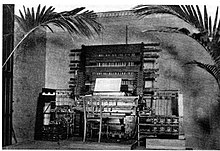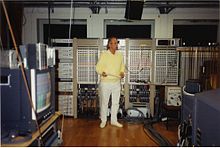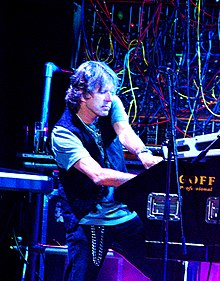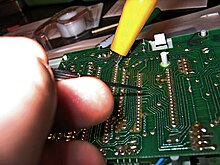Musica electronica


Musica electronica est musica quae instrumenta musica electronica et technologiam musicam electronicam in eius productione adhibet. Distinctio inter sonum ratione electromechanica effecta et sonum technologia electronica effecta ad summam fieri potest.[1] Inter exempla machinarum quae sonum electromechanicum generant sunt telharmonium, organum Hammond, et cithara electrica. Generatio sonorum prorsus electronicorum ex machinis sicut theremin, synthesizator sonorum, et computatrum obtineri potest.[2]
Musica electronica olim cum musica artificiosa Occidentali paene omnino propria consociata est, sed a decennio 197 exeunte, technologiam musicam bene emere significavit musicam ratione electronica generatam magis et magis usitatam in dominio musicae popularis factam esse.[3] Hodie, musica electronica multas comprehendit varietates et genera, a musica artificiosa experimentorum ad genera popularia sicut musica saltationis electronica.
Origines: saeculo 19 exeunte ad saeculum 20 iniens[recensere | fontem recensere]
Facultas sonorum perscribendorum cum productione musicae electronicae saepe sed non necessarie conectitur. Prima machina sonorum perscribendorum nota fuit phonautographum, anno 1857 ab Eduardo Leone Scott de Martinville in tabulas diplomatum relatum. Sonos oculis capere, sed canere non poterat.[4]
Thomas Edison phonographum anno 1878 in tabulas diplomatum rettulit, quod cylindris machinae Raymundi Scott similes usum est. Quamquam cylindri diu in usu erant, Aemilius Berliner discophonum anno 1887 evolvit.[5] Inventum grave, quod deinde musicam electronicam penitus adfecit, fuit tubus audion, a Lee DeForest excogitatus. Hic fuit primus tubus vacuus (accuratius, epistomium thermionicum), anno 1906 effectus, qui ad generationen et amplificationem signorum electricorum, emissionum radiophonicarum, computationis electronicae, et aliarum rerum conduxit. Ante musicam electronicam inventam, compositores magis et magis desiderabant technologiis emergentibus in musica uti. Nonnulla instrumenta facta sunt quae designationes electromechanicas adhibebant atque vicissim facultatem aliorum instrumentorum electronicorum fecit.





Telharmonium, fortasse primum instrumentum electromechanicum (aliquando teleharmonium et dynamophone etiam dictum) a Thaddeo Cahill annos 1898–1912 evolutum est; simplex autem incommodum prosperitatem telharmonii impediebat, ob eius magnitudinem immensam. Primum instrumentum electronicum saepe putatur theremin, a Professore Leone Theremin circa 1919–1920 excogitatum.[6] Inter alia instrumenta electronica temporum primorum sunt crux canorus (Francice croix sonore), a Nicolao Obukhov anno 1926 excogitatus, et undae musicae (Francice ondes musicales, ondes Martenot), in Symphonia Turangalîla aliisque Olivarii Messiaen operibus insignissime adhibitus. Alii compositores, plerumque Francici, inter quos Andreas Jolivet, undis musicis etiam usi sunt.[7]
Genera[recensere | fontem recensere]
Saepe musica electronica et musica technica exaequantur, sed haec solum partem musicae electronicae. Interea species plurimae sunt; hae sunt maximae et vulgatissimae:
Nexus interni
Notae[recensere | fontem recensere]
- ↑ "The stuff of electronic music is electrically produced or modified sounds. . . . Two basic definitions will help put some of the historical discussion in its place: purely electronic music versus electroacoustic music" (Holmes 2002, p. 6).
- ↑ "Electroacoustic music uses electronics to modify sounds from the natural world. The entire spectrum of worldly sounds provides the source material for this music. This is the domain of microphones, tape recorders and digital samplers . . . can be associated with live or recorded music. During live performances, natural sounds are modified in real time using electronics. The source of the sound can be anything from ambient noise to live musicians playing conventional instruments" (Holmes 2002, p. 8).
- ↑ "Electronically produced music is part of the mainstream of popular culture. Musical concepts that were once considered radical—the use of environmental sounds, ambient music, turntable music, digital sampling, computer music, the electronic modification of acoustic sounds, and music made from fragments of speech-have now been subsumed by many kinds of popular music. Record store genres including new age, rap, hip-hop, electronica, techno, jazz, and popular song all rely heavily on production values and techniques that originated with classic electronic music" (Holmes 2002, p. 1). "By the 1990s, electronic music had penetrated every corner of musical life. It extended from ethereal sound-waves played by esoteric experimenters to the thumping syncopation that accompanies every pop record" (Lebrecht 1996, p. 106).
- ↑ Rosen 2008.
- ↑ Russcol 1972, p. 67.
- ↑ Anonymous 2001.
- ↑ Orton & Davies n.d.
Bibliographia[recensere | fontem recensere]
- Aitken, Stuart (10 May 2011), "Charanjit Singh on How He Invented Acid House … by Mistake", The Guardian (Londinii) (10 May)
- Anderson, Jason (28 Novembris 2008), Slaves to the Rhythm: Kanye West Is the Latest to Pay Tribute to a Classic Drum Machine, CBC News website
- Angus, Robert (1984), "History of Magnetic Recording, Part One", Audio Magazine (August): 27–33
- Ankeny, Jason (n.d.), Yellow Magic Orchestra: Biography, Allmusic.com
- Ankeny, Jason (2010), Kraftwerk: Biography, Allmusic.com.
- Anonymous (n.d.(1)), Inventing the Wire Recorder, Recording History: The History of Recording Technology (http://www.recording-history.org/).
- Anonymous (n.d.(2)), "Synth pop", Allmusic. (archive on 10 March 2011)
- Anonymous (1972), Liner notes to The Varese Album, Columbia Records
- Anonymous (1979), "Artists and Producers Strive for Inroads Overseas", Billboard (26 May): J–14, J–31
- Anonymous (2001), Guide ID A520831 (Edited), "Theremin", BBC h2g2 encyclopaedia project (2 April)
- Anonymous (2006), "1935 AEG Magnetophon Tape Recorder", Mix: Professional Audio and Music Production (mixonline.com)
- Bassingthwaighte, Sarah Louise (2002), "Electroacoustic Music for the Flute", DMA dissertation (Seattle: Universitas Vsaingtoniae)
- Bayly, Richard; Varèse; Ussachevsky, L.; Varese (1982–83), "Ussachevsky on Varèse: An Interview April 24, 1979 at Goucher College,", Perspectives of New Music 21 (Fall–Winter 1982 and Spring–Summer 1983): 145–51
- Begault, Durand R (1994), 3-D Sound for Virtual Reality and Multimedia, Boston: Academic Press, 1994, ISBN 978-0120847358. (Online reprint, NASA Ames Research Center Technical Memorandum facsimile 2000.
- Brick, Howard (2000), Age of Contradiction: American Thought and Culture in the 1960s, Ithaca: Cornell University Press., ISBN 0801487005 (Primum editus: Novi Eboraci: Twayne, 1998)
- Bush, John (n.d.(a)), Tomita: Biography, Billboard.com website
- Bush, John (n.d.(b)), Snowflakes Are Dancing: Electronic Performances of Debussy's Tone Paintings, Isao Tomita, Allmusic.com
- Bush, John (2009), Song Review: 'Blue Monday', Allmusic website
- Busoni, Ferruccio (1962), 'Sketch of a New Esthetic of Music, Translated by Dr. Th. Baker and originally published in 1911 by G. Schirmer. Reprinted in Three Classics in the Aesthetic of Music: Monsieur Croche the Dilettante Hater, by Claude Debussy; Sketch of a New Esthetic of Music, by Ferruccio Busoni; Essays before a Sonata, by Charles E. Ives, Novi Eboraci: Dover Publications, Inc., pp. 73–102
- Bussy, P. (2004), Kraftwerk: Man, Machine and Music (3rd ed.), Londinii: SAF, ISBN 0946719705
- Chadabe, Joel (1997), Electric Sound: The Past and Promise of Electronic Music, Upper Saddle River, Novae Caesareae: Prentice Hall
- Chadabe, Joel (2004), "Electronic Music and Life"", Organised Sound 9 (1): 3–6
- Chowning, John (1973), "The Synthesis of Complex Audio Spectra by Means of Frequency Modulation", Journal of the Audio Engineering Society 21 (7): 526–34.
- Collins, Nick (2003), "Generative Music and Laptop Performance", Contemporary Music Review 22 (4): 67–79.
- Crab, Simon (2005), The Hammond Novachord (1939), 120 Years of Electronic Music website
- Dobrian, Christopher (2002), Current Research Projects.
- Donhauser, Peter (2007), Elektrische Klangmaschinen, Vienna: Boehlau.
- Doornbusch, Paul (2005), The Music of CSIRAC, Australia's First Computer Music, with accompanying CD recording, Australia: Common Ground Publishers, ISBN 1-86335-569-3.
- Eimert, Herbert (1958), "What Is Electronic Music?", Die Reihe 1 (Editio Anglica): 1–10.
- Eimert, Herbert (1972), "How Electronic Music Began", Musical Times 113 (1550 (April)): 347–349. (Primum editus Theodisce in Melos 39 (Jan.-Feb. 1972):42–44.)
- Emmerson, Simon (1986), The Language of Electroacoustic Music, Londinii: Macmillan.
- Emmerson, Simon, ed. (2000), Music, Electronic Media, and Culture, Aldershot (Hants.), Burlington (VT): Ashgate, ISBN 0754601099
- Emmerson, Simon (2007), Living Electronic Music, Aldershot (Hants.), Burlington (VT): Ashgate, ISBN 0754655466
- Engel, Friedrich Karl (2006), Walter Weber's Technical Innovation at the Reichs-Rundfunk-Gesellschaft, Richardhess.com
- Engel, Friedrich Karl; Hammar, Peter (2006), A Selected History of Magnetic Recording, edited by Richard L. Hess, Richardhess.com
- Frankenstein, Alfred (1964), "Space-Sound Continuum in Total Darkness", San Francisco Chronicle (October 17)
- Fujii, Koichi (2004), "Chronology of Early Electroacoustic Music in Japan: What Types of Source Materials Are Available?", Organised Sound 9: 63–77
- Gard, Stephen (2004), Nasty Noises: 'Error' as a Compositional Element, Sydney Conservatorium of Music, Sydney eScholarship Repository
- Glinsky, Albert (2000), Theremin: Ether Music and Espionage, Music in American Life, foreword by Robert Moog., Urbanae etSicagi: University of Illinois Press, ISBN 0252025822
- Gluck, Robert J (2005), "Fifty Years of Electronic Music in Israel", Organised Sound 10 (2): 163–80.
- Griffiths, Paul (1995), Modern Music and After: Directions Since 1945, Oxoniae et Novi Eboraci: Oxford University Press, ISBN 0198165781
- Hammar, Peter (1999), "John T. Mullin: The Man Who Put Bing Crosby on Tape", Mix Online (1 October)
- Harris, Craig (n.d.), Tom Dissevelt: Biography, Allmusic.com
- Hertelendy, Paul (2008), Spatial Sound's Longest Running One-Man Show, artssf.com
- Holmes, Thomas B (2002), Electronic and Experimental Music: Pioneers in Technology and Composition (Second ed.), Londinii: Routledge Music/Songbooks, ISBN 0415936438
- Holmes, Thom (2008), Electronic and Experimental Music: Technology, Music, and Culture (third ed.), Londinii et Novi Eboraci: Routledge, ISBN 0415957818
- Johnson, Steven (2002), The New York Schools of Music and Visual Arts: John Cage, Morton Feldman, Novi Eboraci: Routledge, ISBN 0415936942
- Krause, Manfred (2002), "AES Convention 112 (April)", The Legendary 'Magnetophon' of AEG, Audio Engineering Society E-Library. Abstract.
- Kurtz, Michael (1992), Stockhausen: A Biography, Conv. Richard Toop, Londinii: Faber and Faber, ISBN 0571143237
- Jenkins, Mark (2007), Analog Synthesizers: Understanding, Performing, Buying: From the Legacy of Moog to Software Synthesis, Amsterdam: Elsevier, ISBN 9780240520728.
- Lebrecht, Norman (1996), The Companion to 20th-Century Music, Da Capo Press., ISBN 0-306-80734-3
- Loy, Gareth (1985), "About Audium - A Conversation with Stanley Shaff", Computer Music Journal 9 (2 (Summer 1985)): 41–48.
- Luening, Otto (1964), "Some Random Remarks About Electronic Music", Journal of Music Theory 8 (1 (Spring)): 89–98.
- Luening, Otto (1968), "An Unfinished History of Electronic Music", Music Educators Journal 55 (3 (November)): 42–49, 135–42, 145.
- Macon, Edward L (1997), Rocking the Classics: English Progressive Rock and the Counterculture, Oxoniae et Novi Eboraci: Oxford University Press, ISBN 0195098870.
- Maginnis, Tom (N.d.), [Musica electronica at Allmusic The Man Who Dies Every Day: Ultravox: Song Review], Allmusic.com. (archive at webcitation.org)
- Mattis, Olivia (2001), "Mathews, Max V(ernon)", The New Grove Dictionary of Music and Musicians, edited by Stanley Sadie and John Tyrell, Londinii: Macmillan.
- Montanaro, Larisa Katherine (2004), "A Singer's Guide to Performing Works for Voice and Electronics", DMA thesis (Austin: The University of Texas at Austin).
- Morawska-Büngeler, Marietta (1988), Schwingende Elektronen: Eine Dokumentation über das Studio für Elektronische Musik des Westdeutschen Rundfunk in Köln 1951–1986, Cologne-Rodenkirchen: P. J. Tonger Musikverlag.
- Norman, Katharine (2004), Sounding Art: Eight Literary Excursions through Electronic Music, Aldershot: Ashgate Publishing, Ltd, ISBN 0754604268
- Orton, Richard; Davies, Hugh (n.d.), "Ondes martenot", Grove Music Online (Oxford Music Online (Subscription access)).
- Ozab, David (2000), Beyond the Barline: One Down, Two to Go, ATPM (About This Particular Macintosh) website
- Peyser, Joan (1995), The Music of My Time, White Plains Novi Eboraci: Pro/AM Music Resources Inc.; Londinii: Kahn and Averill, ISBN 0-912483-99-7;
- Rappaport, Scott (2007), "Digital Arts and New Media Grad Students Collaborate Musically across Three Time Zones", UC Santa Cruz Currents Online (2 April).
- Reid, Gordon (2004), "The History Of Roland Part 1: 1930–1978", Sound on Sound (November)
- Roads, Curtis (1996), The Computer Music Tutorial, Cantabrigiae Massachusettae: MIT Press, ISBN 0-262-18158-4
- Rosen, Jody (27 Martii 2008), "Researchers Play Tune Recorded before Edison", New York Times (27 March).
- Russ, Martin (2009), Sound Synthesis and Sampling (third ed.), Amsterdam and Boston: Elsevier; Oxford and Burlington: Focal, ISBN 0240521056.
- Russcol, Herbert (1972), The Liberation of Sound: An Introduction to Electronic Music, Englewood Cliffs Novae Caesareae: Prentice-Hall.
- Russolo, Luigi (1913), "L'arte dei rumori: manifesto futurista", Manifesti del movimento futurista 14, Milano: Direzione del movimento futurista. English version as "The Art of Noise: Futurist Manifesto 1913", A Great Bear Pamphlet 18, translated by Robert Filliou, Novi Eboraci: Something Else Press. Liber Anglice conversus secundus: "The Art of Noises", Monographs in Musicology no. 6, translated from the Italian with an introduction by Barclay Brown, Novi Eboraci: Pendragon Press, ISBN 0918728576.
- Scaruffi, Piero (2003), A History of Rock Music 1951–2000, Novi Eboraci: iUniverse, ISBN 0595295657.
- Schutterhoef, Arie van (2007), Sogitec 4X, Knorretje, een Nederlandse Wiki over muziek, geluid, soft- en hardware.
- Schwartz, Elliott (1975), Electronic Music, Novi Eboraci: Praeger.
- Snell, Karen Crocker (2006), "The Man Behind The Sound", Santa Clara Magazine (Santa Clara University) (Summer)
- Snyder, Jeff (n.d.), Pierre Schaeffer: Inventor of Musique Concrete.
- Sofer, Danny; Lynner, Doug (1977), "Pat Gleeson", Synapse: the Electronic Music Magazine 1 (5 (January–February)): 21–24, 35.
- Stevenson, Joseph (2004), Tomita: Biography, Allmusic website
- Stockhausen, Karlheinz (1971), Texte zur Musik, 3, edited by Dieter Schnebel. DuMont Dokumente, Coloniae: DuMont Buchverlag, ISBN 3770104935
- Stockhausen, Karlheinz (1978), Texte zur Musik, 1970-1977, 4, edited by Christoph von Blumröder. DuMont Dokumente., Cologne: DuMont Buchverlag, ISBN 3-7701-1078-1
- Tal, Josef; Markel, Shlomo (2002), Musica Nova in the Third Millennium, Tel-Aviv: Israel Music Institute, ISBN 9659056508. Etiam Theodisce: Musica Nova im dritten Millenium, Tel-Aviv: Israel Music Institute, ISBN 9659056500
- Tyson, Jeff (n.d.), How Movie Sound Works, Entertainment.howstuffworks.com
- Ungeheuer, Elena (1992), Wie die elektronische Musik "erfunden" wurde...: Quellenstudie zu Werner Meyer-Epplers musikalischem Entwurf zwischen 1949 und 1953, Kölner Schriften zur neuen Musik, 2, Mainz et Novi Eboraci: Schott, ISBN 3795718910.
- Unterberger, R (2002), "Progressive rock", All Music Guide to Rock: the Definitive Guide to Rock, Pop, and Soul, in V. Bogdanov, C. Woodstra and S. T. Erlewine, eds, (3rd ed.), Milwaukee, Visconsiniae: Backbeat Books, ISBN 087930653X.
- Vercoe, Barry (2000), "Forward", The Csound Book: Perspectives in Software Synthesis, Sound Design, Signal Processing, and Programming, edited by Richard Boulanger, Cambridge, Mass.: MIT Press, pp. xxvii–xxx, ISBN 0262522616.
- Vine, Richard (15 Iunii 2011), "Tadao Kikumoto Invents the Roland TB-303", The Guardian (Londinii) (14 June)
- Watson, Scott (2005), "A Return to Modernism", Music Education Technology Magazine (February).
- Weidenaar, Reynold (1995), Magic Music from the Telharmonium: The Story of the First Music Synthesizer, Metuchen, Novae Caesareae: Scarecrow Press, Inc., ISBN 0810826925.
- Yabsley, Alex (2007), Back to the 8 Bit: A Study of Electronic Music Counter-Culture, Gamemusic4all.com
- Zimmer, Dave (2000), Crosby, Stills and Nash: The Authorized Biography, Photography by Henry Diltz, Novi Eboraci: Da Capo Press, ISBN 0306809745
- Zussman, John Unger (1982), "Jazzing It Up at the NCC: Hancock and Apple II Make Music Together", InfoWorld 4 (26 (5 Iulii)): 1, 5
Bibliographia addita[recensere | fontem recensere]
- Bogdanov, Vladimir (2001), Chris Woodstra, Stephen Thomas Erlewine, et John Bush, ed., The All Music Guide to Electronica: The Definitive Guide to Electronic Music, AMG Allmusic Series, San Francisco: Backbeat Books, ISBN 0879306289
- Cummins, James (2008), Ambrosia: About a Culture: An Investigation of Electronica Music and Party Culture, Toronto Ontarii: Clark-Nova Books, ISBN 978-0978489212
- Heifetz, Robin J., ed. (1989), On The Wires of Our Nerves: The Art of Electroacoustic Music, Cranbury Novae Caesareae: Associated University Presses, ISBN 0838751555
- Kahn, Douglas (1999), Noise, Water, Meat: A History of Sound in the Arts, Cambridge Massachusettae: MIT Press, ISBN 0262112434
- Kettlewell, Ben (2001), Electronic Music Pioneers, [N.p.]: Course Technology, Inc., ISBN 1931140170
- Licata, Thomas, ed. (2002), Electroacoustic Music: Analytical Perspectives, Westport Connecticutae: Greenwood Press, ISBN 0313314209
- Manning, Peter (2004), Electronic and Computer Music (Revised and expanded ed.), Oxoniae et Novi Eboraci: Oxford University Press, ISBN 0195144848
- Prendergast, Mark (2001), The Ambient Century: From Mahler to Trance: The Evolution of Sound in the Electronic Age, Forward [sic] by Brian Eno., Novi Eboraci: Bloomsbury, ISBN 0747542139.
- Reynolds, Simon (1998), Energy Flash: A Journey Through Rave Music and Dance Culture, Londinii: Pan Macmillan, ISBN 0330350560 (US title, Generation Ecstasy: Into the World of Techno and Rave Culture, Bostoniae: Little, Brown, 1998 ISBN 0316741116; Novi Eboraci: Routledge, 1999 ISBN 0415923735)
- Schaefer, John (1987), New Sounds: A Listener's Guide to New Music, Novi Eboraci: Harper Collins, ISBN 0060970812
- Shanken, Edward A. (2009), Art and Electronic Media, Londinii: Phaidon, ISBN 9780714847825
- Shapiro, Peter, ed. (2000), Modulations: a History of Electronic Music: Throbbing Words on Sound, Novi Eboraci: Caipirinha Productions, ISBN 189102406X
- Sicko, Dan (1999), Techno Rebels: The Renegades of Electronic Funk, Novi Eboraci: Billboard Books, ISBN 0823084280
- Wells, Thomas (1981), The Technique of Electronic Music, Novi Eboraci Schirmer Books; Londinii: Collier Macmillan, ISBN 978-0028728308
Nexus externi[recensere | fontem recensere]
| Vicicitatio habet citationes quae ad Musica electronica spectant. |
- Ars Civitatum: Electronica, artofthestates.org (parva operum electronicorum compositorum Civitatum Foederatarum conlectio
- "The Computation Laboratory at the University of Melbourne's Dept of Computer Science and Software Engineering," www.cs.mu.oz.au (CSIRAC)
- Historia instrumentorum musicae electronicae, www.obsolete.com
- Sedes Musica Computatrorum, music.columbia.edu
- Societas Fundata Musicae Electronicae, www.emf.org
- Temporum ordo computatrorum et musicae electronicae, www.doornbusch.net
- Temporum ordo musicae electronicae www.music.psu.edu
